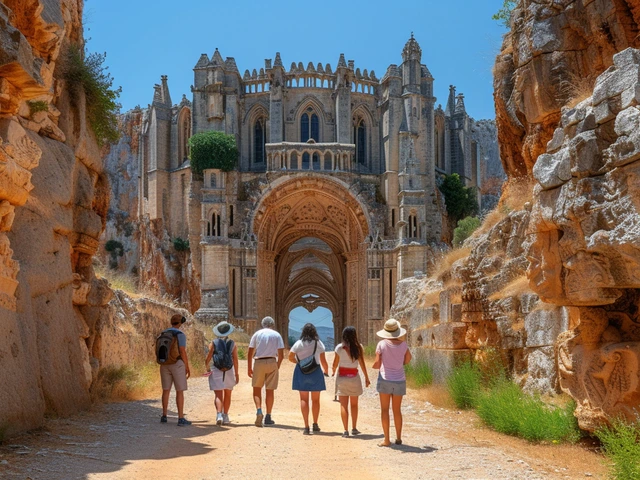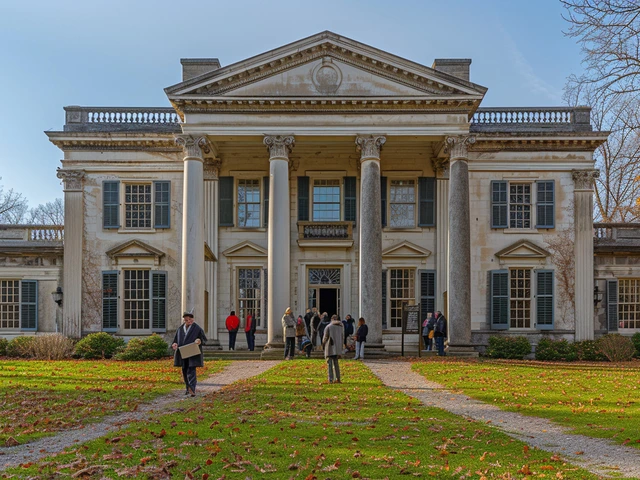Unveiling Gothic Revival's Fascinating Roots
I've always had a penchant for the dramatic and the intricate – qualities that I find beautifully wrapped in the architectural style known as Gothic Revival. This isn't about vampires or melancholic poems; it's about stone, glass, and sky-reaching spires. Originating in the late 1740s, Gothic Revival drilled into the romanticized past, a chivalrous era that might not have been so glamorous, if you had to actually live through it, what with the lack of antibiotics and all. Let's just say, as much as I ramble about the beauty of the past, I nod in gratitude to modern-day plumbing and medicine.
Imagine this: you're walking through the cobblestone streets, the mist languidly lifting, and there, like a sentinel of an ancient time, stands a building that could very well be the backdrop of a Jane Austen novel. It's the Gothic Revival architecture, with its origins deeply entrenched in medieval design – a nod to the significance of the past. As a history enthusiast, delving into the rebirth of this style almost feels like reviving the names and narratives of the artists that shaped it. You can sense the shadow of Horace Walpole's 'Strawberry Hill', generally recognized as the first Gothic Revival house, with every ribbed vault and pointed arch you encounter.
Decoding the Characteristic Features
I must confess, I relish in pointing out the signature elements of Gothic Revival architecture to Emilia – a pastime of ours during our travels, often accompanied by Jaden's gentle eye-rolling. As I bombard them with trivia, we'd regard the distinctive characteristics that send my historical heart aflutter: the pointed arches that scream 'Gothic' from miles away. Let's not forget the ribbed vaults, flying buttresses, and those elongated windows that look like they've been stretched by some medieval torture device. I just adore those stained-glass panels that paint the walls with colors so vivid you'd think you’re walking into a kaleidoscope.
Now, let's chat about the pinnacles and spires, shall we? They're like the crowns jewel – no respectable Gothic Revival building is caught without them. Except, you know, when they are. Because architectural styles, much like the best-laid plans of mice and men, often go awry. Yet, when they stand, they kiss the sky with grace, complexity, and perhaps a hint of divine aspiration. And in every ornate facade, in every labyrinthine detail lies the essence of Gothic Revival: an eternal struggle to reach towards something greater – which, quite frankly, is mood I can relate to every morning before my first cup of coffee.
Embracing the Eccentric: Gothic Revival in Residential Design
One might think that Gothic Revival is reserved for grand cathedrals or imposing public buildings, but hold on to your horse-drawn carriages, because the fun doesn't stop there. Residential designs aplenty have boomed under this style's aesthetic umbrella. Now, you won't find me living in a house with turrets and battlements – although imagine that for a moment, standing on your own turret, proclaiming: "I am the king of the barbecue!", but you have to admit the thought has crossed your mind, even if for a whimsical second.
These homes, peppered across various landscapes, mirror the grandiose designs of their larger counterparts, on a humbler scale, of course. Yet, despite their reduced stature, these abodes are no less intricate, with gothic windows and decorative woodwork that make you feel like you're living in your own private novel. Emilia often jests that living in such a house might require us to adopt more stately names, and alas, she might be on to something. Picture receiving mail addressed to Sir Theodore and Lady Emilia – though significantly less grandiose when it's just the electricity bill.
The Spread of Gothic Revival Across Continents
Gothic Revival is a globetrotter – seriously, it gets around more than I do, and I used to think I was savvy with my handful of international stamps in my passport. Its high ornate fingers have touched everything from the rugged terrain of Scotland to the shimmering shores of Australia. One may observe it in the splendor of the Parliament Hill in Ottawa or in the formidable visage of the Cathedral of Learning in Pittsburgh. It's ubiquitous, and yet, remarkably adaptive to the local flair of wherever it lays its stone foundations.
Delightful little anecdote: Emilia and I strolled through the grounds of the University of Sydney during our last visit. We couldn't help but marvel at the Gothic Revival grandeur set before us, prompting us to engage in witty repartee reminiscent of academic elites - if only briefly before Jaden reminded us that we were, in fact, there to visit the Harry Potter store. Apparently, that's how you draw the next generation to appreciate historic architecture nowadays.
Notable Examples to Satisfy Your Gothic Itch
Allow me to steer you through a curated directory of Gothic Revival gems that would knock the socks off any architecture enthusiast. The Houses of Parliament in London stand tall as a paragon of this style. I recall the way the structure seemed to rise out of the fog like a page lifted from a Dickens novel the first time I laid eyes on it – oh, but let's not forget the cathedral-like stations of the London Underground, either.
An unconventional example? The Palace of Westminster resplendent by night, with its reflection dancing on the Thames like it's practicing for 'Strictly Come Dancing'. Kudos to Sir Charles Barry and Augustus Pugin, the Steve and Danny of their day, responsible for its design. Do tip your hat to the fortitude of the Big Ben as well, still ticking after all these years. Truly, there's no shortage of this architectural muse in the UK.
Modern Day Echoes of a Bygone Era
Now, it's easy to think that our technologically advanced age would have little room for the extravagant echoes of a bygone era. But Gothic Revival is like that eccentric uncle at family gatherings who simply refuses to retire his disco moves, somehow staying relevant despite the odds. You'll find contemporary interpretations of those same characteristic features, albeit less melodramatic, in newer institutions and even some forward-thinking homes.
I chuckle at the thought of explaining to Jaden why a certain building has a seemingly unnecessary turret – but it does make for great hide and seek. I've seen modern takes on the style that don't quite reach the lofty heights of their predecessors but still manage a respectful curtsy to the historical essence of the style: sleek lines that hint at pointed arches, geometric patterns that give a nod to the ornate tracery, and the occasional colorful window.
The Cultural Significance and Legacy of Gothic Revival
To merely suggest that Gothic Revival is eye candy for history buffs or architecture nerds is to woefully undersell its cultural kapow. This style is steeped in significance, embodying a philosophical return to values and ethos of what was considered a nobler time, despite the questionable hygiene. For artists and architects of the era, it was less about playing dress-up in stone and mortar, and more about a profound discourse on aesthetics and societal ideals that resonate to this day.
Once, while visiting a Gothic Revival library, I imagined myself a scholar of old, perusing tomes of forgotten lore while the stained-glass windows cast their chromatic spell over ancient texts. It's that allure, that mysterious gravitas that beckons us to explore not only the external beauty but the internal narrative that these buildings hold. Emilia once commented that walking through a Gothic Revival building is akin to walking through someone else's dream – vivid, intricate, and occasionally nonsensical, but invariably unforgettable.
Preservation Efforts and The Future of Gothic Revival
It's not all ancient tombs and rose-colored glasses, though. We live in an age where the new often overshadows the old, where glass skyscrapers and minimalist designs tend to hog the limelight. The struggle to preserve the craftsmanship of the Gothic Revival era is real, like trying to keep your favorite vinyl records from bending in the heat. For those of us who are aficionados of the style, it’s not just about maintaining the structures – it's about upholding a piece of history, securing a tactile connection to the past for future generations.
Emilia and I have mused over what future archaeologists might think of our erstwhile preservation efforts. Perhaps Jaden, with all his youthful wisdom, will one day gaze upon these historic monuments with the same blend of wonder and reflection as his old man. The point is, every stained-glass window that is restored, every spire that is reinforced, and every ornate gargoyle that is conserved serves as a testament to our ongoing conversation with history – because, like Gothic Revival, some stories are just too compelling not to be retold. And now, if you'll excuse me, I believe there's a turret somewhere calling my name.





